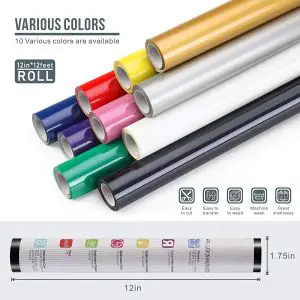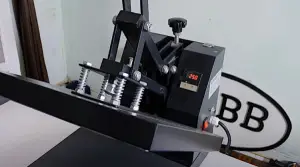
Heat Pressing 100% Polyester – Step By Step Guide
In this article, a step-by-step guide will be provided for heat pressing 100% polyester garments.
What is a heat press machine?
A heat press machine is a device that allows you to transfer artwork or designs onto clothing materials, garments, cooking ware, hat brims, wood, mugs, cups, T-shirts, hats, and other fabric accessories.
Check out our article – 5 Best Hat Heat Press Attachments & Machines Review
If you are wondering if it is possible to print heat transfer vinyl on 100% polyester, the answer is yes.
But hold on a minute!
The process isn’t as straightforward as printing heat transfer vinyl (HTV) on cotton. You’ll need to take extra care when printing heat transfer vinyl on polyester, as you’ll need a longer press time and lower temperatures. Plus, practice and testing are necessary to determine whether the fabric and HTV are compatible. Continue reading to learn tips for printing HTV on polyester.
Heat Press Machine VS Household Iron: Which Is Better For Heat Pressing 100% Polyester?
Heat press machines are recommended instead of household irons when pressing polyester with HTV. Regular household irons only allow you to use light pressure. In contrast, a heat press machine allows you to use the machine with high pressure, making it easier to apply HTV to polyester. So, invest in a good heat press machine if you plan to print HTV on polyester fabrics.
Here Are The 5 Best Selling Heat Press Machines This Year!
| Products | Ratings | Price |
|---|---|---|
| Fancierstudio Digital Heat Press Machine | 9.9/10 [Editor's Choice] | Check Price |
| TUSY Heat Press Machine | 9.8/10 | Check Price |
| VEVOR 5 in 1 Combo Heat Press Machine | 9.6/10 | Check Price |
| Seeutek Heat Press 12" X 10" Machine | 9.6/10 | Check Price |
| TUSY 5 in 1 Heat Press Machine Pro | 9.6/10 | Check Price |
Heat pressing 100% polyester fabrics can be accomplished with the right temperature settings and careful timing. Heat press machines are good to own, and they can be calibrated to the correct temperature and time. An ordinary household iron will not be able to do this.
Check out our article – 11 Best Heat Press Machines to Buy – All Brands Reviewed
Here Is How To Use Heat Press On 100% Polyester:
The following steps will explain how to use a heat press machine on polyester.
Step 1: Read The Label
Before you begin printing, be sure to carefully read the item’s label that you plan to print on. There should be a manufacturer’s label on every item that tells you what the material is made of. In order to set the correct temperature on your heat-press, you need to know the type of fabric you’re using.
Tip: Avoid pre-washing the fabric
The polyester fabric should be smooth and dry when you press HTV on it. So, pre-washing your fabric isn’t necessary. But it is important to refer once again to the product description or tag. You may want to check with the manufacturer to see if it has specifically instructed you to pre-wash the garment before printing HTV on it. If so, make sure you do it. Otherwise, don’t bother pre-washing.
Step 2: Selecting The Right Heat Transfer Vinyl
It is also important to choose an appropriate HTV for 100% polyester fabrics. The best heat transfer vinyl for 100% polyester is from the Sooez HTV collection. For polyester garments, thin and stretchable heat transfer vinyl is highly recommended.
This Amazing Sooez Heat Transfer Vinyl Roll Is Highly Rated On Amazon
Step 3: Choose A Teflon Sheet
It is possible for polyester fabrics to scorch or burn when they are heat pressed. Therefore, when pressing the HTV decal in the heat press machine, a cover sheet should be used to cover the whole decal and fabric. A thin Teflon sheet is recommended for use as a heat transfer cover, since thick sheets may cause problems with the temperature while pressing. Moreover, it’s important that it covers the entire garment, so make sure it’s large enough.
This Teflon Sheet Below Is A Best-Seller On Amazon
Although heat transfer vinyl is covered with a carrier sheet, it is still necessary to cover your fabric with a Teflon sheet to ensure that it is protected from damage.
Check out our article – 12 Best Vinyl Heat Press Machines in 2021 [Reviewed All Machines]
Step 4: Set Appropriate Temperature & Time
Credit: APM-Designs
The following settings are recommended for Heat Pressing 100% Polyester:
- Temperature settings: Not exceeding 270 degrees F
- Time settings: Upto 10 seconds
A print’s quality is also affected by how long the item is left inside the press. Textiles like cotton that are less sensitive to heat can be left on the heated plate for longer periods of time. It is generally recommended that polyester be left in the press for only 10 seconds at a time (although the time may vary depending on the type of item and the instructions in the user manual).
After that, check that the HTV has adhered to the polyester. In case it does not stick, then press it again for another five seconds. Make sure to follow the manual’s instructions when using any device!
Step 5: Perform A Test Print
Credit: Heat Press Hangout
When you are printing on polyester for the first time, you should always practice through a test print. Cut a small piece of polyester to practice or buy an extra polyester garment for testing.
Basically, you are testing the perfect combination of heat press settings and time during the test print. Check whether your polyester discolors when heat-pressed at different temperatures and times. Wash the polyester that was printed with HTV after the test print. The reason is that you want to see if the material has discolored or if the vinyl is peeling. Once you’ve figured out the best combination, you’re done testing.
Step 6: Pre-Heat The Fabric
Credit: Dreams Time
The fabric should be preheated (without putting a Teflon sheet over it). Set the temperature setting to 270 degrees Fahrenheit to preheat your garment. Then, place the garment on the heat press. Make sure there are no wrinkles. After that use medium pressure for approximately 5 seconds on the area where you will be transferring your design to pre-press or pre-heat it.
Heat pressing HTV into a garment requires this step in order to remove moisture and smooth the surface. You may not be able to apply an HTV decal to a garment if you don’t pre-press it.
Step 7: Print
Now it’s time to print!
Make sure the machine is set to the correct temperature. Place the design on your fabric and cover it with a Teflon sheet. By pressing down the pressurized handle, you will seal the fabric and Teflon sheet between the heat plate and the work table. When working with polyester, you should maintain light pressure on the handle since too much pressure can cause scorching or melting.
Lastly, peel the transfer paper away while the poly is still warm. That’s it. This is how you heat press vinyl on 100% polyester (specifically, heat transfer vinyl).
Credit: Silver Bobbin
See This YouTube Video Explaining Heat Pressing On 100% Polyester Fabric
FAQ’s
1- What is the correct temperature for pressing HTV on 100% polyester?
In order to apply HTV to 100% polyester, a heat press must be set no higher than 270 degrees Fahrenheit. It is advisable not to use high temperatures on polyester, since burn marks and discoloration may result. Moreover, when using any device, be sure to follow the manual’s instructions!
2- What can be done to avoid burn marks on polyester?
Burn marks caused by scorching are yellowish to brownish in color, much like those caused by regular household irons. In some cases, this is caused by keeping HTV decals on polyester for an extended period. You can avoid this by:
- Strictly following the recommended temperature and time settings for polyester.
- Covering the fabric with a cover sheet (Teflon sheet) while heat pressing.
3- Can you put 100% polyester in the dryer?
It is safe to wash polyester in a warm washing machine and to dry it in a normal setting in the dryer. However, polyester can shrink or warp if left in hot water or drier for an extended period of time. There is a greater tendency for polyester blends to shrink than pure polyester (100% polyester).
Final Thoughts
Using a heat press on 100% polyester is now a breeze with these tips and tricks! It is very important to keep an eye on the temperature so that you don’t end up with discoloration or shiny scorch marks on your fabric. Making use of the tips mentioned above and finding the right combination will do the trick. Thanks for choosing our article that provided step-by-step instructions on heat pressing 100% polyester fabrics and hope you have great success with it.
Best Deals on Amazon
PowerPress Digital Sublimation Heat Press Machine
CREWORKS Heat Press Machine
Check Price on AmazonVIVOHOME Multifunctional Heat Press Transfer Machine
Check Price on AmazonI specialize in writing tech-based product reviews for over 3 years now. My blogs aim to provide well-researched and informative content to help people make informed purchasing decisions.














